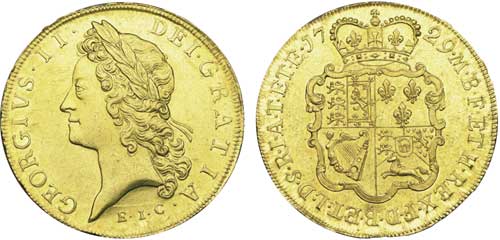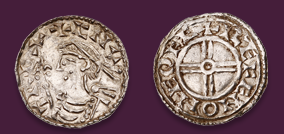
Auction: 5028 - The Samuel King Collection of Highly Important British Gold Coins
Lot: 161
xGeorge II, Five Guineas, 1729, e.i.c (East India Company) provenance below young laureate head left, georgivs.ii. dei.gratia., toothed border both sides, rev. inverted die axis, crowned quartered shield of arms, crown band less ornate, seven hearts to Hanoverian Arms, eleven strings to Irish harp, Scottish Arms with inner frame of lis, date at top, .m.b.f.et.h.rex.f.d.b.et.l.d.s.r.i.a.t.et.e., edge inverted inscription in raised letters, inverted N´s in anno, +decvs.et.tvtamen anno.regni.tertio (Schneider 556; MCE.279; S.3664), surface marks and hairlines, some light edge knocks and small pinhole by R of regni and S of decvs, otherwise extremely fine with considerable brilliance Estimate £ 7,000-9,000 Mrs E M Norweb, Part 2, Spink Coin Auction 48, 13 November 1985, lot 530The E.I.C gold coinage of George II was struck from bullion supplied to the Mint by the East India Company. The bullion was obtained by the East India Company through its trading activities in Asia where it enjoyed an exclusive monopoly. Ironically the demise of the silver coinage through lack of substantial quantities of bullion later in the 18th Century can be attributed to the massive expansion of the Company´s trade in Asian markets. Bullion from the New World that would otherwise have been coined at the Mint was exported to Asia to exchange for goods. The collapse of New World bullion sources in the 1750s was a motivating factor in the East India Company´s evolution as a territorial power on the Indian sub-continent.
Sold for
£6,000




